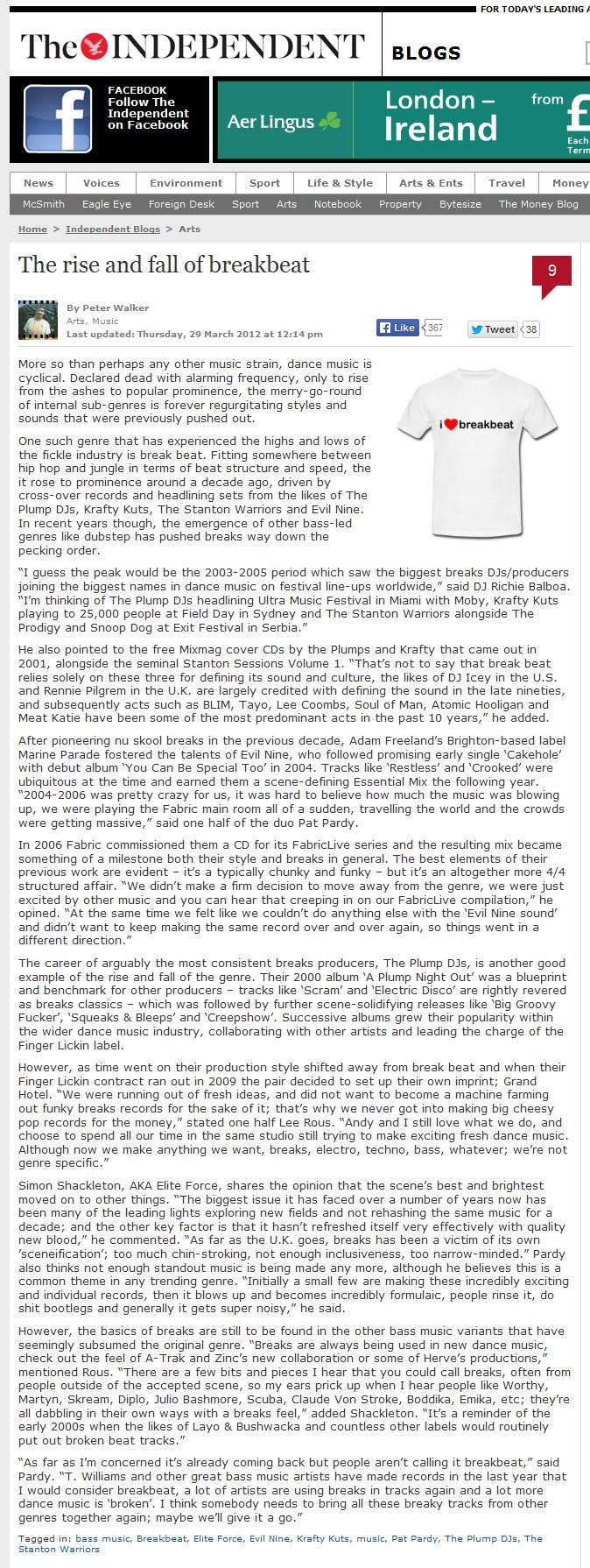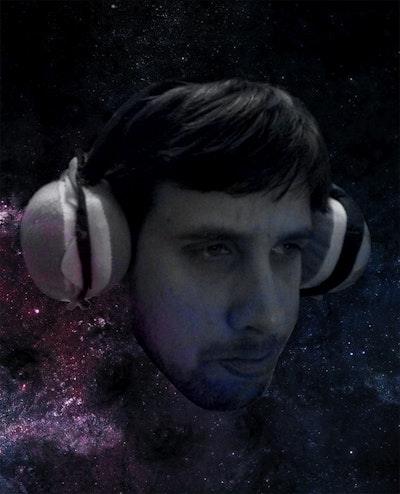The Rise and Fall of Breakbeat
The Independent

I love break beat. I love it because it’s one of the only genres of dance music that actually makes me dance. I remember seeing the Plump DJs and Stanton Warriors at The Arches in 2003 and bumping into a friend, who upon seeing me flailing limbs like an epileptic, was convinced I was on something; when it was just the infectious beat pattern to blame.
Crucially though my love for breaks has waned in recent years. The first five years of the new millennium were something of a golden age for break beat, with the likes of the Plumps, Stanton Warriors, Evil Nine and Ils all making great music; with every decent nightclub putting on a night to accommodate it. I think my first taste of the genre was hearing Adam Freeland’s 1999 compilation ‘Tectonics’. I was just moving from trance to progressive house at the time and here was something completely different; combining the best of choppy jungle/hip hop beats with futuristic techy sounds. Tracks like Tsunami One and BT’s ‘Hip Hop Phenomenon’, Layo & Bushwacka’s ‘Deep South’ and their mix of ‘Isokora’ by Leuroj, all still stand the test of time. This was followed a couple of years later by the Plumps’ Urban Underground compilation, which again documented the best of the emerging genre with things like Buckwacka’s huge cross-over ‘Monster’, Lee Coombs’ Old School Acid Dub of ‘My Definition’ by DJ Technique and their own mixes of Stakker Humanoid and JDS’ ‘Nine Ways’. From 2001 onwards things just got better and better: Finger Lickin’ was pumping out landmark releases at a rate of knots, Distinctive’s Y4K compilation series was smashing it and Marine Parade was at the forefront of the nascent nu breaks scene.
“I guess the peak would be the 2003-2005 period which saw the big three of Krafty Kuts, Plump DJs and Stanton Warriors cement their names as global superstar DJ/producers and joining the biggest names in dance music on festival line-ups worldwide,” DJ Richie Balboa told me. “I’m thinking of Krafty Kuts playing to 25,000 people at field day in Sydney, The Plump DJs headlining Ultra Music Festival in Miami with Moby and The Stanton Warriors playing alongside The Prodigy and Snoop Dog at Exit Festival in Serbia.” He also pointed to the free Mixmag cover CDs by the Plumps and Krafty Kuts which came out at the turn of the last century, alongside the seminal Stanton Sessions Volume 1. “That’s not to say that breakbeat relies solely on these three for defining its sound and culture, the likes of DJ Icey in the U.S. and Rennie Pilgrem in the U.K. are largely credited with defining the sound in the late nineties, and subsequently acts such as BLIM, Tayo, Lee Coombs, Soul of Man, Atomic Hooligan and Meat Katie have been some of the most predominant acts in the past 10 years,” he added.
The Brighton duo Evil Nine perhaps had the most influence on break beat crossing over and blowing up when they followed the brilliant ‘Cakehole’ with debut album ‘You Can Be Special Too’ in 2004. Tracks like ‘Restless’ and ‘Crooked’ were ubiquitous at the time and earned them an Essential Mix the following year, which has to go down as one of the best ever put together. “2004-2006 after the release of You Can Be Special Too were pretty crazy for us, it was hard to believe how much the music was blowing up, we were playing the Fabric main room all of a sudden, travelling the world and the crowds were getting massive,” says one half of the group Pat Pardy. By 2006 they had been commissioned to put together a CD for the FabricLive series and the resulting mix became something of a milestone both their style and breaks in general. The best elements of their previous work are evident - typically chunky and funky - but it’s an altogether more 4/4 affair. “We didn't make a firm decision to move away from the genre, we were just excited by other music and you can hear that creeping in on our Fabric Live compilation,” he told me. “At the same time we felt like we couldn't do anything else with the 'Evil Nine sound' and didn't want to keep making the same record over and over again, so things went in a different direction.”
I was still going to breaks nights fairly regularly at that point, but reading over old reviews it’s clear that the sets I was hearing from my favourite DJs were increasingly plundering other genres for inspiration. I really liked his ‘These are the Breakss’ CD, but seeing Krafty Kuts play in 2007 was clearly the last straw for me, as I wrote at the time: “Soon after midnight Krafty Kuts appears, with a set displaying both his talents and failings. Large sections of good, tough underground breaks - like new Plump DJs' track ‘Listen to the Baddest’ - were ruined by the kind of lazy formulaic tunes that are blighting the scene, like an unforgivable Calvin Harris bootleg. And don't get me started on the ego-boosting samples he drops every half hour.” Mr Martin Reeves aside, it did seem that the quality and quantity of breakbeat music being produced was on the wane and as a consequence, or perhaps it was a consequence of, DJs seemed to be moving into other areas of dance music.
I put this theory to a number of the scene’s leading lights, with some interesting insights. “The basic supposition in the question is that breakbeat as peaked and is on a downhill trend,” responded Simon Shackleton; AKA Elite Force. “It has changed for sure, and the biggest issue it has faced over a number of years now has been many of the leading lights exploring new fields and not rehashing the same music for a decade; and the other key factor is that it hasn't refreshed itself very effectively with quality new blood,” he stated. “As far as the UK goes, breaks has been a victim of its own 'sceneification'; too much chin-stroking, not enough inclusiveness, too narrow-minded.”
At the same time British break beat was slipping off the radar, other bass-music variants were rising to prominence, so I wanted to investigate what affect genres like dub-step had on the scene. The career of arguably the most consistent breaks producers, The Plump DJs, is a good example of this. Their 2000 album ‘A Plump Night Out’ was a blueprint and benchmark for other producers – tracks like ‘Scram’ and ‘Electric Disco’ are rightly revered as breaks classics – which was followed by further scene-solidifying releases like ‘Big Groovy Fucker’, ‘Squeaks & Bleeps’ and ‘Creepshow’. While their 2003 album ‘Eargasm’ suffered from the common second album ‘let’s do loads of ultimately ill-fitting vocal collaborations’ syndrome, and ‘Saturday Night Lotion’ in 2005 was distinctly patchy in places, they were still producing incendiary breaks beasts like ‘Get Kinky’. A rare remix by D.Ramirez of ‘Electric Disco’ in 2006 showed cross-over appeal and ‘System Addict’ in 2007 was my favourite guilty pleasure that year, but from then on they’ve gone firmly down the electro route, splitting from Finger Lickin’ in 2009 after their contract ran out and opening their own outlet Grand Hotel a year later to get more production freedom.
“We were running out of fresh ideas, and did not want to become a machine farming out funky breaks records for the sake of it; that’s why we never got into making big cheesy pop records for the money,” stated one half Lee Rous. “We rejoice in memories of the heyday of the breaks scene and feel so lucky to be an integral part of that era. We love playing those old tunes at the end of our set, but we must innovate and stimulate minds.” He disagrees that other genres have been responsible for the reducing popularity of breaks though, arguing that innovation and evolution of dance music should be celebrated. “It’s mostly due to slow but sure cultural changes, the rise of other forms of dance music, and the natural ebb and flow of life. The scene had its plusses and minuses, over time it’s natural for folks to get used to the good bits and slowly pissed off with the bad bits; apparently there are club kids are calling it 'dancey dubstep' these days,” he continued. Pardy also thinks that breaks’ peak and trough theme is common in any trending genre. “Initially a small few are making these incredibly exciting and individual records, then it blows up and becomes incredibly formulaic, people rinse it, do shit bootlegs and generally it gets super noisy,” he said. “People are gonna hate me for this, but I think it's down to the fact that people within the breakbeat scene aren't making standout music, I wish they did, but they don't, and it brings a tear to my eye that the music we loved and the scene that embraced does little for me these days,” he added.
However, the basics of breaks are still to be found in the other bass music variants that have seemingly subsumed the original genre. “Breaks are always being used in new dance music, check out the feel of A-Trak and Zinc’s new collaboration or some of Herve's productions,” mentioned Rous. “There are a few bits and pieces I hear that you could call breaks, often from people outside of the accepted scene, so my ears prick up when I hear people like Worthy, Martyn, Skream, Diplo, Julio Bashmore, Scuba, Claude Von Stroke, Boddika, Emika, etc; they’re all dabbling in their own ways with a breaks feel,” added Shackleton. “It's a reminder of the early 2000s when the likes of Layo & Bushwacka and countless other labels would routinely put out broken beat tracks.” It remains to be seen when or whether breaks will truly re-emerge, but it’s nice to hear that the best artists of its best era still love the genre as much as I do. “T. Williams and other great bass music artists have made records in the last year that I would consider breakbeat, a lot of artists are using breaks in tracks again and a lot more dance music is 'broken'. I think somebody needs to bring all these breaky tracks from other genres together again; maybe we'll give it a go.”
